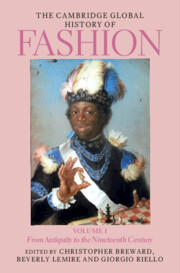Book contents
- The Cambridge Global History of Fashion
- The Cambridge Global History of Fashion
- The Cambridge Global History of Fashion
- Copyright page
- Contents for Volume I
- Figures for Volume I
- Maps for Volume I
- Table for Volume I
- Contributors for Volume I
- Preface
- 1 Global History in the History of Fashion
- Part I Multiple Origins of Fashion
- 2 Towards a History of Fashion Without Origins
- 3 Fashion in the Ancient World
- 4 Fashion on the Silk Roads, 500–1300
- 5 Distinguishing Oneself
- 6 The Material Regulation of Fashion
- Part II Early Modern Global Entanglements
- Part III Many Worlds of Fashion
- Index
- References
4 - Fashion on the Silk Roads, 500–1300
from Part I - Multiple Origins of Fashion
Published online by Cambridge University Press: 04 August 2023
- The Cambridge Global History of Fashion
- The Cambridge Global History of Fashion
- The Cambridge Global History of Fashion
- Copyright page
- Contents for Volume I
- Figures for Volume I
- Maps for Volume I
- Table for Volume I
- Contributors for Volume I
- Preface
- 1 Global History in the History of Fashion
- Part I Multiple Origins of Fashion
- 2 Towards a History of Fashion Without Origins
- 3 Fashion in the Ancient World
- 4 Fashion on the Silk Roads, 500–1300
- 5 Distinguishing Oneself
- 6 The Material Regulation of Fashion
- Part II Early Modern Global Entanglements
- Part III Many Worlds of Fashion
- Index
- References
Summary
4000 embroidered qabā’s, 4000 ridā’s of silk lined with sable, mink and other furs, 10000 qamīses and ghilālas, 10000 khaftāns, 2000 pair of sirwal of different kinds, 4000 imāmas, 1000 hoods, 1000 capes of different kinds, 5000 kerchiefs of different kinds, 1000 special suits of armour, 50000 ordinary suits of armour, 10000 helmets, 4000 pair of khuff, most lined with sable, mink, and other furs, 4000 pair of jawrab.1
- Type
- Chapter
- Information
- The Cambridge Global History of FashionFrom Antiquity to the Nineteenth Century, pp. 78 - 108Publisher: Cambridge University PressPrint publication year: 2023

